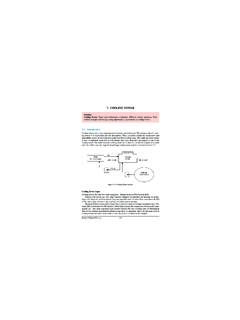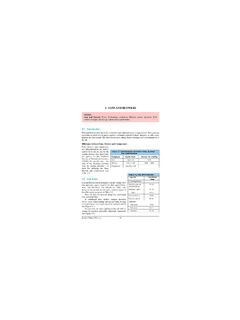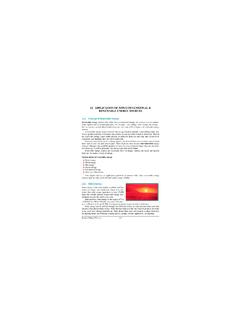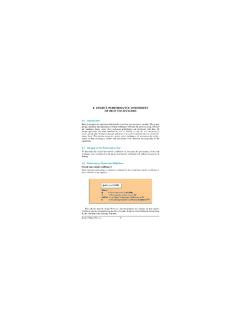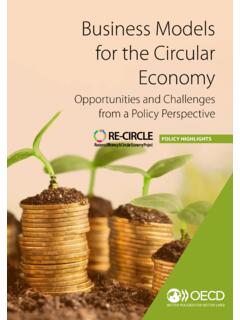Transcription of 3. ENERGY MANAGEMENT AND AUDIT
1 54 Bureau of ENERGY EfficiencySyllabusEnergy MANAGEMENT & AUDIT :Definition, ENERGY AUDIT - need, Types of ENERGY AUDIT , ENERGY MANAGEMENT ( AUDIT ) approach-understanding ENERGY costs, Bench marking, Energyperformance, Matching ENERGY use to requirement, Maximizing system efficiencies,Optimizing the input ENERGY requirements, Fuel and ENERGY substitution, ENERGY auditinstruments"The judicious and effective use of ENERGY to maximize profits (minimizecosts) and enhance competitive positions"(Cape Hart, Turner and Kennedy, Guide to ENERGY MANAGEMENT Fairmont press inc. 1997)"The strategy of adjusting and optimizing ENERGY , using systems and procedures so as toreduce ENERGY requirements per unit of output while holding constant or reducing totalcosts of producing the output from these systems" Definition & Objectives of ENERGY ManagementThe fundamental goal of ENERGY MANAGEMENT is to produce goods and provide services with theleast cost and least environmental effect.
2 The term ENERGY MANAGEMENT means many things to many people. One definition of ener-gy MANAGEMENT is:Another comprehensive definition is The objective of ENERGY MANAGEMENT is to achieve and maintain optimum ENERGY procurementand utilisation, throughout the organization and: To minimise ENERGY costs / waste without affecting production & quality To minimise environmental AUDIT : Types And MethodologyEnergy AUDIT is the key to a systematic approach for decision-making in the area of ENERGY man-agement. It attempts to balance the total ENERGY inputs with its use, and serves to identify allthe ENERGY streams in a facility. It quantifies ENERGY usage according to its discrete ENERGY AUDIT is an effective tool in defining and pursuing comprehensive ENERGY man-agement per the ENERGY Conservation Act, 2001, ENERGY AUDIT is defined as "the verification, mon-3. ENERGY MANAGEMENT AND AUDIT3. ENERGY MANAGEMENT and Audit55 Bureau of ENERGY Efficiencyitoring and analysis of use of ENERGY including submission of technical report containing rec-ommendations for improving ENERGY efficiency with cost benefit analysis and an action plan toreduce ENERGY consumption".
3 Need for ENERGY AuditIn any industry, the three top operating expenses are often found to be ENERGY (both electricaland thermal), labour and materials. If one were to relate to the manageability of the cost orpotential cost savings in each of the above components, ENERGY would invariably emerge as atop ranker, and thus ENERGY MANAGEMENT function constitutes a strategic area for cost AUDIT will help to understand more about the ways ENERGY and fuel are used in anyindustry, and help in identifying the areas where waste can occur and where scope for improve-ment ENERGY AUDIT would give a positive orientation to the ENERGY cost reduction, preventivemaintenance and quality control programmes which are vital for production and utility activi-ties. Such an AUDIT programme will help to keep focus on variations which occur in the energycosts, availability and reliability of supply of ENERGY , decide on appropriate ENERGY mix, identi-fy ENERGY conservation technologies, retrofit for ENERGY conservation equipment general, ENERGY AUDIT is the translation of conservation ideas into realities, by lendingtechnically feasible solutions with economic and other organizational considerations within aspecified time frame.
4 The primary objective of ENERGY AUDIT is to determine ways to reduce ENERGY consumptionper unit of product output or to lower operating costs. ENERGY AUDIT provides a " bench-mark"(Reference point) for managing ENERGY in the organization and also provides the basis for plan-ning a more effective use of ENERGY throughout the Type of ENERGY AuditThe type of ENERGY AUDIT to be performed depends on:-Function and type of industry-Depth to which final AUDIT is needed, and -Potential and magnitude of cost reduction desiredThus ENERGY AUDIT can be classified into the following two )Preliminary Auditii)Detailed Preliminary ENERGY AUDIT MethodologyPreliminary ENERGY AUDIT is a relatively quick exercise to: Establish ENERGY consumption in the organization Estimate the scope for saving Identify the most likely (and the easiest areas for attention Identify immediate (especially no-/low-cost) improvements/ savings Set a 'reference point' Identify areas for more detailed study/measurement Preliminary ENERGY AUDIT uses existing, or easily obtained data3.
5 ENERGY MANAGEMENT and Audit56 Bureau of ENERGY Detailed ENERGY AUDIT MethodologyA comprehensive AUDIT provides a detailed ENERGY project implementation plan for a facility,since it evaluates all major ENERGY using type of AUDIT offers the most accurate estimate of ENERGY savings and cost. It considersthe interactive effects of all projects, accounts for the ENERGY use of all major equipment, andincludes detailed ENERGY cost saving calculations and project a comprehensive AUDIT , one of the key elements is the ENERGY balance. This is based on aninventory of ENERGY using systems, assumptions of current operating conditions and calculationsof ENERGY use. This estimated use is then compared to utility bill charges. Detailed ENERGY auditing is carried out in three phases: Phase I, II and III. Phase I - Pre AUDIT PhasePhase II - AUDIT PhasePhase III - Post AUDIT PhaseA Guide for Conducting ENERGY AUDIT at a GlanceIndustry-to-industry, the methodology of ENERGY Audits needs to be flexible.
6 A comprehensive ten-step methodology for conduct of ENERGY AUDIT at field level is pre-sented below. ENERGY Manager and ENERGY Auditor may follow these steps to start with andadd/change as per their needs and industry ENERGY MANAGEMENT and Audit57 Bureau of ENERGY EfficiencyTen Steps Methodology for Detailed ENERGY Audit3. ENERGY MANAGEMENT and Audit58 Bureau of ENERGY Efficiency3. ENERGY MANAGEMENT and Audit59 Bureau of ENERGY EfficiencyPhase I -Pre AUDIT Phase ActivitiesA structured methodology to carry out an ENERGY AUDIT is necessary for efficient working. Aninitial study of the site should always be carried out, as the planning of the procedures neces-sary for an AUDIT is most Site Visit and Preparation Required for Detailed AuditingAn initial site visit may take one day and gives the ENERGY Auditor/Engineer an opportunity tomeet the personnel concerned, to familiarize him with the site and to assess the procedures nec-essary to carry out the ENERGY the initial site visit the ENERGY Auditor/Engineer should carry out the followingactions: - Discuss with the site's senior MANAGEMENT the aims of the ENERGY AUDIT .
7 Discuss economic guidelines associated with the recommendations of the AUDIT . Analyse the major ENERGY consumption data with the relevant personnel. Obtain site drawings where available - building layout, steam distribution, compressed airdistribution, electricity distribution etc. Tour the site accompanied by engineering/production The main aims of this visit are: - To finalise ENERGY AUDIT team To identify the main ENERGY consuming areas/plant items to be surveyed during the AUDIT . To identify any existing instrumentation/ additional metering required. To decide whether any meters will have to be installed prior to the AUDIT eg. kWh, steam,oil or gas meters. To identify the instrumentation required for carrying out the AUDIT . To plan with time frame To collect macro data on plant ENERGY resources, major ENERGY consuming centers To create awareness through meetings/ programmePhase II- Detailed ENERGY AUDIT ActivitiesDepending on the nature and complexity of the site, a comprehensive AUDIT can take from sev-eral weeks to several months to complete.
8 Detailed studies to establish, and investigate, energyand material balances for specific plant departments or items of process equipment are carriedout. Whenever possible, checks of plant operations are carried out over extended periods oftime, at nights and at weekends as well as during normal daytime working hours, to ensure thatnothing is AUDIT report will include a description of ENERGY inputs and product outputs by majordepartment or by major processing function, and will evaluate the efficiency of each step of themanufacturing process. Means of improving these efficiencies will be listed, and at least a pre-liminary assessment of the cost of the improvements will be made to indicate the expected pay-back on any capital investment needed. The AUDIT report should conclude with specific recom-mendations for detailed engineering studies and feasibility analyses, which must then be per-formed to justify the implementation of those conservation measures that require investments.
9 3. ENERGY MANAGEMENT and Audit60 Bureau of ENERGY EfficiencyThe information to be collected during the detailed AUDIT includes: consumption by type of ENERGY , by department, by major items of process equipment, by balance data (raw materials, intermediate and final products, recycledmaterials, use of scrap or waste products, production of by-products for re-use in otherindustries, etc.) cost and tariff and material flow and distribution of site services ( air, steam). of ENERGY supply ( electricity from the grid or self-generation) for fuel substitution, process modifications, and the use of co-generationsystems (combined heat and power generation). MANAGEMENT procedures and ENERGY awareness training programs within the baseline information and reports are useful to get consumption pattern, production costand productivity levels in terms of product per raw material inputs. The AUDIT team should col-lect the following baseline data:-Technology, processes used and equipment details-Capacity utilisation -Amount & type of input materials used -Water consumption-Fuel Consumption-Electrical ENERGY consumption-Steam consumption-Other inputs such as compressed air, cooling water etc -Quantity & type of wastes generated-Percentage rejection / reprocessing-Efficiencies / yieldDATA COLLECTION HINTSIt is important to plan additional data gathering carefully.
10 Here are some basic tips to avoid wasting timeand effort: measurement systems should be easy to use and provide the information to the accuracy that is needed, not the accuracy that is technically possible measurement equipment can be inexpensive (flow rates using a bucket and stopwatch) the quality of the data must be such that the correct conclusions are drawn (what grade of product is on, is the production normal etc) define how frequent data collection should be to account for process variations. measurement exercises over abnormal workload periods (such as startup and shutdowns) design values can be taken where measurements are difficult (cooling water through heat exchanger)DO NOT ESTIMATE WHEN YOU CAN CALCULATEDO NOT CALCULATE WHEN YOU CAN MEASURE3. ENERGY MANAGEMENT and Audit61 Bureau of ENERGY EfficiencyDraw process flow diagram and list process steps; identify waste streams and obviousenergy wastage An overview of unit operations, important process steps, areas of material and ENERGY use andsources of waste generation should be gathered and should be represented in a flowchart asshown in the figure below.

